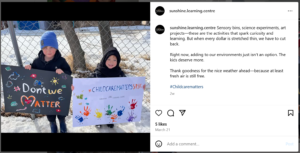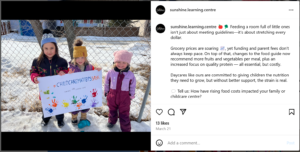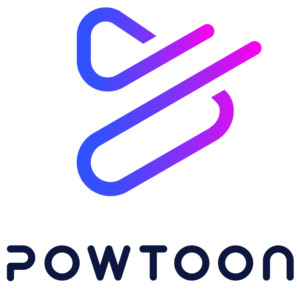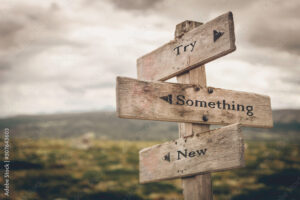In today’s digital world, social media has become more than just a platform for selfies and status updates—it’s also a powerful space for activism, awareness, and advocacy. But how meaningful is online activism, really? Can it spark real-world change, or is it just “slacktivism” in disguise? As educators and community leaders, we’re often caught in the tension between wanting to speak up and fearing the backlash—or worse, the silence—that can follow.
I’ve wrestled with these questions personally, especially in my role as Chair of the Sunshine Learning Centre Daycare. Recently, we found ourselves in a difficult position: facing the reality that if we didn’t raise our voices, we could be forced to shut our doors. Our team launched an online campaign to shine a light on the government’s inequitable daycare funding model—one that left community-led programs like ours struggling to stay afloat while others thrived. It wasn’t easy, but going public with our story helped build awareness, attract allies, and push for more equitable treatment. That experience showed me the real potential of digital activism when it’s rooted in truth, community, and purpose.
In this post, I’ll explore whether social media activism can be meaningful and worthwhile, whether productive conversations about social justice online are possible, and what responsibilities we carry as educators when it comes to modelling active, thoughtful citizenship in digital spaces.
So I ask myself: Is Online Social Media Activism Meaningful and Worthwhile?
Webster’s dictionary (2025) defines slacktivism as “the practice of supporting a political or social cause by means such as social media or online petitions, characterized as involving very little effort or commitment.” Often some of these popular movements like #idlenomore or #blacklivesmatter get mistaken for this idea of slacktivism. However, while it’s true that likes and shares don’t always translate into real change, we can’t overlook the power of these platforms to amplify voices, raise awareness, and connect people to action. In fact, some of these movements have even gone so far as to keep the larger institutions people are fighting against, held accountable and make meaningful changes reflecting policy and procedures later on.
Joel Westheimer’s article What Kind of (Digital) Citizen? helps frame this further. He distinguishes between three kinds of citizens: the personally responsible, the participatory, and the justice-oriented. The justice-oriented citizens critically examine the root causes of issues and work to transform systems. As an educator, I would ask myself: how can I encourage this kind of deep engagement, both in myself and in my students (who are sometimes also teachers), particularly when it comes to the digital world?
Productive Conversations About Social Justice Online
Let’s be real—talking about social justice online can be messy. It’s easy for things to get misunderstood or taken out of context, and we’ve all seen those heated comment threads where nobody’s listening, all they want to do is post something negative. But even with all that, I still think there’s potential for good conversation. I’ve seen it happen in educator groups I’m part of, where people come in with open minds and leave with new perspectives. I’ve also learned a lot from posts that break things down in ways that are clear, honest, and invite reflection.
I think part of having those productive conversations is being willing to sit in discomfort, and maybe even admit when we don’t know everything. We don’t always have to be experts—just being open and respectful goes a long way. That’s also something we can model for our students. If we want them to be thoughtful online, we need to show them how we navigate difficult conversations, even when they’re uncomfortable.
Silence, Complicity, and Responsibility
The phrase “silence speaks louder than words” has been sitting with me ever since I read Katia’s blog post. It’s so true. I’ve had moments where I’ve debated whether or not to say something online—wondering if I’ll get it wrong or if someone will come after me for it. But the truth is, when we choose to stay silent, especially as educators silence does say something. I have learned through my training, “non-violent crisis intervention”, silence is also a form of communication. And often, it says that the issue isn’t important enough to speak on, but it can also say sooo many more negative things as well. I’ve second-guessed myself after reading upsetting things on social media and messaged my friends beforehand to get their take on the issue and see if my feelings are an overreaction or warranted, often they are warranted.
When we shared our story about the Sunshine Learning Centre Daycare and the unfair funding model, it wasn’t easy. We were scared—what if no one listened? What if it backfired and parents were upset? But if we didn’t say something, we could be forced to shut our doors. Speaking up helped us rally support, and it reminded me that even a single voice—when shared with honesty and heart—can start a ripple. We followed up the campaign with a letter, and multiple calls to the ministers office. We are still fighting the good fight. 
As educators, people look to us. And when we stay quiet, it can send a message that inequity is just “the way it is.” But we know better—and we can do better.
The Educator’s Role in Modeling Active Digital Citizenship
So, what’s our role in all this?
Honestly, I think it starts with showing up online the same way we hope our students will. That means sharing thoughtfully, engaging with kindness, and using our voices when it matters. We don’t need to be influencers or post every day, but when we do speak, we can model what it looks like to care out loud.
It also means being honest about the messiness. We can talk to our students about how to spot misinformation, how to handle disagreements without tearing people down, and how to think critically before reposting something just because it “sounds right.” These are real skills, ones they’ll carry with them far beyond the classroom.
At the end of the day, we’re not just teaching content. We’re shaping citizens. If we want them to care about the world, we have to show them what that looks like in our world, too.
So What, Now What?
Is social media activism perfect? Nope. But is it meaningful? Absolutely, if we use it intentionally.
We’ve seen time and time again that online platforms can raise awareness, build community, and push for real change. As educators, we don’t get to sit on the sidelines. Whether we’re speaking out about an injustice, supporting a movement, or simply being mindful of what we share, we’re setting the tone for our students and fellow colleagues.
So next time something shows up on your feed that makes you pause, ask yourself: Is this a moment to speak? To share? To learn? Because our digital voice matters—and the way we use it might just inspire someone else to do the same.









